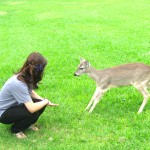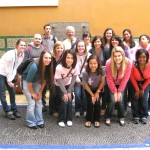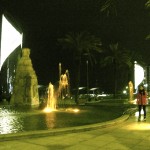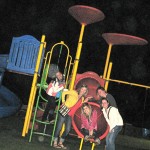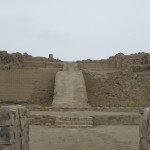Jun
10
This is my first post since arriving in Italy. It has been such a long week. Internet has been hard to come by, so I guess I’ll try to make this one count.
We arrived in Rome on schedule. The flights were fine. Well.. except the part where they wake you up a few hours after you fell asleep and tell you it’s morning. Now… the sun was up and shining, which was very convincing. But my body didn’t agree. The only good part was being handed coffee immediately.
I traveled with 3 girls straight from Oklahoma City. We met up with another girl in Chicago and a fifth once we arrived in Rome. The six of us got a deal on a van to our hotel in the middle of Rome. Well, it went nearly to our hotel. I consider wandering around a city, pulling luggage, being exhausted, and looking clueless is part of the experience. Rome was beautiful. I miss it. I feel like we were there for a long time. Each day, we got up, had some bread and coffee, and started our trek with our professor through the city. The weather was beautiful, but sunny. By the end of the day, we were all covered in sweat and groaning about our feet.
The buildings and art were amazing. There was this moment, while I was looking at a Bernini sculpture, when I realized that this trip was going to be significant for me. I’ve never cared for art history as much as a studio art major should. Seeing the work in person changes everything. Photos in books can be inspiring, but standing near a famous piece of art and realizing there is a reason that it’s famous does more. It’s moving. And then it’s humbling. It makes me feel like I can never be an artist because I need to improve so much. The thing about me, fortunately, is I find being told I can’t do something extremely motivating. Even if I am the one saying it. Oh I can’t? Watch me.
I’m leaving out a lot, but just know the academic side of things has been action packed and the non-class cultural experiences have been a number of things: enlightening, complicated, confusing, and hilarious to name a few.
Next, we took a private bus to Sienna. It was such a nice place. We were only there for an afternoon, but it was worth it. We saw art in a very small museum and then our professor sent us on a mission. In Sienna, there are 17 neighborhoods that all have different animal names and compete in a horse race. We were told to ask locals about their neighborhoods and which neighborhoods were their rivals. It felt like being part of the Amazing Race. Minus the physical labor and plus gelato. There is always gelato involved. I was lucky in that no one was mean to me and several people were very helpful. Some girls said that they were kicked out of stores for asking, even if they had already made purchases.
So far, people have mostly been nice. Lots of people have been unfriendly, but not mean. Some people, specifically men, have been overly welcoming. It’s a strange thing to be blatantly propositioned and (after firmly declining, of course) not even feeling that offended. I think I’d like to deck a guy if he was so blunt in Oklahoma. Here, it is easy to brush off.
We are in Florence now. It smells like cigarettes and leather. And food, if you’re standing in the right places. I like this city. The walls of the buildings are very tall and the streets are very narrow. There are more tourists here than I’ve ever seen in my life. The guides hold sticks with flowers or decorations on the ends or umbrellas to keep from losing their flocks. It’s very strange to be in a foreign place and hear so many American voices around. It isn’t what I expected, but I’m spending time on the beaten path. I wish I had more time here to better get to know the city, but we leave on Friday.
So far, I like both of my courses. The art history professor, Kirk, is great. I think I’ve learned a lot. I doubt I’ll be telling him any time soon, but I credit his teaching style. He calls it practical. I haven’t spent much time with the other professor, Stephanie, since she won’t be with us regularly until we get to Arezzo, but she seems very sharp and kind. These people are great sources of information. This program is one where you get back whatever you put in. I’m doing my best to get a lot back.
I may not have internet for a bit, but I’ll update when I get the chance.
Ciao
Anne
Jun
9


We visited PromPeru for a tour and presentation.
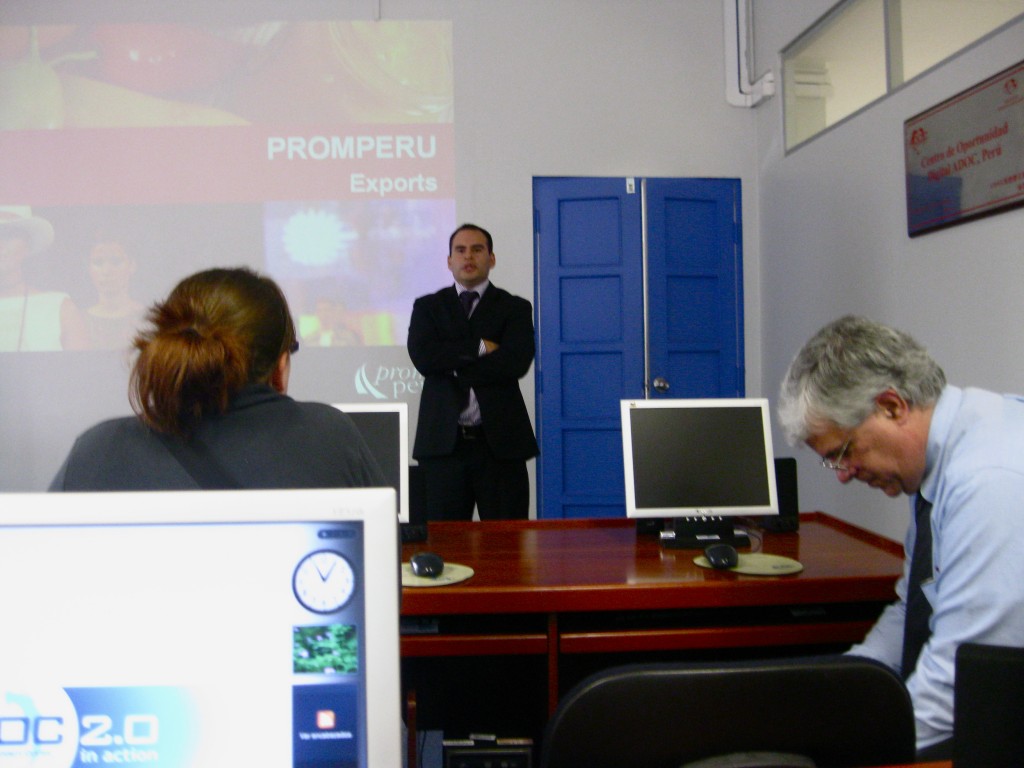
PromPeru gave us a private presentation of their programs and goals.

It's great to see so many citizens attend the workshop to better their economy and living conditions!

This is what a typical class at Ponticia Universidad Catolic del Peru looks like. Notice how attentive we are!
It’s another cloudy day. My clothes are still not dry after three days because it’s been cloudy. And our room smells like wet dogs since it’s covered in wet clothes. Proomie also did laundry, but we managed to fit all our clothes on the unused top bunk.
I miss the American clothes dryer, but I’m in Peru so I can’t complain! Apparently we had a small earthquake overnight–I must have slept through it! I’m such a heavy sleeper.
We started the day earlier at 8 a.m. instead of 9, but I was less sleepy. We visited PromPeru for a tour and presentation. PromPeru is a commission for the promotion of exportation and tourism in Peru. We participated in the workshop that’s free to all, and then an official gave us a private presentation upstairs of PromPeru’s programs and goals. It’s great to see so many citizens attend the workshop to better their economy and living conditions!
We had rice, beef and sweet potatoes with Peruvian sauce drizzled on top, flan and pear juice for lunch. We went to the campus bookstore and bought pens and sweaters.
I bought a Pontificia Universidad Catolica del Peru sweater in a crimson color. Boomer Sooner from PUCP!
We switched things up today and had class in the afternoon instead of morning. I’m not sure that’s a good idea since we usually get sleepy after lunch. We learned about the economy of Latin America in today’s class. It’s nice to be done by 5 p.m. today for a change, but there’s construction next door to our host home. I also miss laws of the U.S.A. That sounds silly, but it seems like there’s not much of law and order here in Peru. There are not (or at least that I know of) any laws about construction work. Construction goes on until late here in Peru…MUST IGNORE DRILLING NOISES.
We had rice, mashed potatoes and chicken with a special Peruvian sauce and caramel crepes and Peruvian ice cream for dinner. The mother of our host mom is such a great cook!
Dr. Kenney had plans with his family, but we enjoyed our host dad’s company. I had a long conversation with Ricardo, our host dad, about traveling and the importance of experiencing the world. He knows all about that since he owns a travel agency. I love practicing Spanish with him because he makes me feel comfortable, and I’m not worried about being wrong.
I jammed to music via my iTunes library with my housemate and watched Usher music videos wishing we were the girls in the videos. Hahaha not really…but Usher is good-looking!
We have bonded so much so quickly! It’s just something about traveling and getting to know a country that makes us all bond.
I can’t believe we have been in Peru for 11 days!
Jun
8

Fr. David, originally from the United States now a Peruvian citizen, visited us at the Peyton Center and spoke about his studies and experiences.
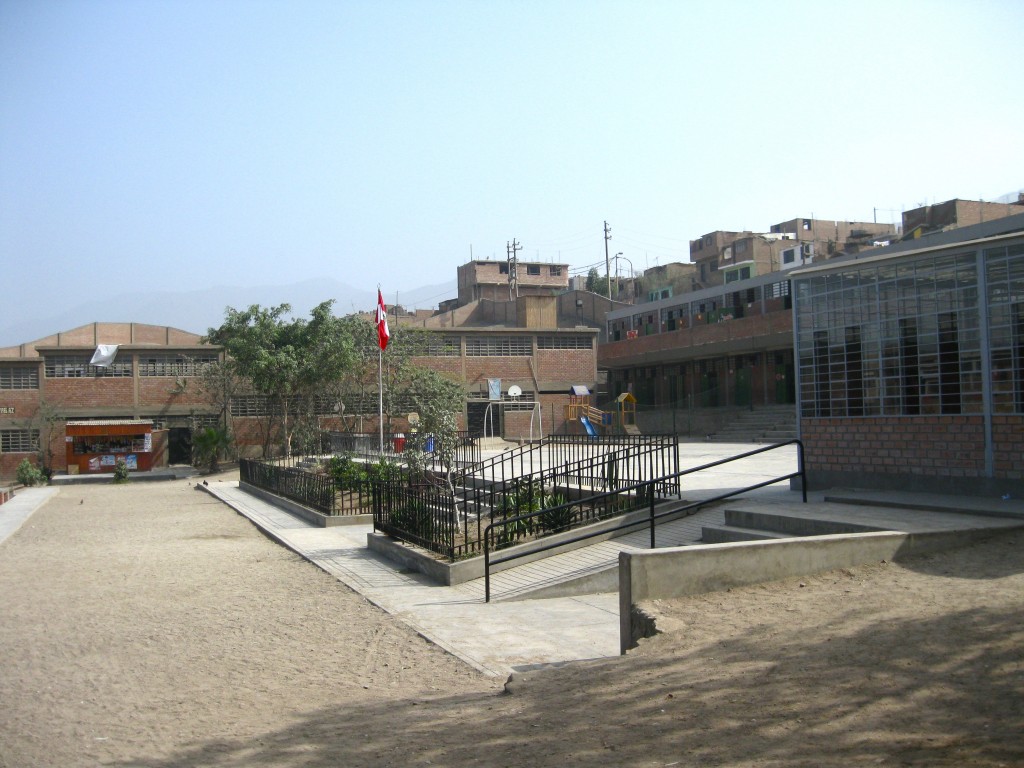
My favorite activity of the day is the visit to Fe Y Alegre No. 25 (Faith and Joy) school. Students there are ages 4 through 17.

The younger students were so precious. I took many pictures of them. They sang and danced for us.

I wanted to take home every child as souvenirs!

I love being around children because they remind us to enjoy the little things in life.

Our last activity of the day was a visit to La Lombriz Feliz (The Happy Worm) ecology center, garden and worm farm in Canto Grande.
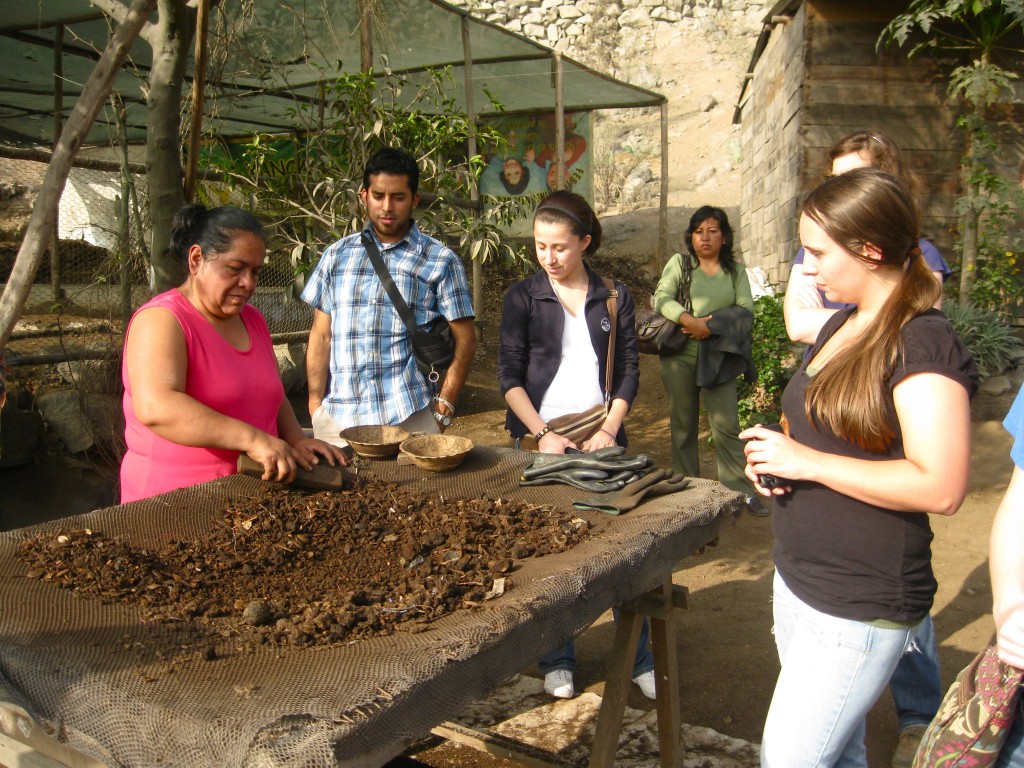
La Lombriz Feliz is in a very poor area once surrounded by trash. Community leaders created this to decrease neighborhood contamination by separating trash by organic (to turn into compost), nonorganic (to recycle) and nonusable (to trash appropriately).

If it weren’t for this ecology center, the neighborhood would not have very much greenery. I’m so glad community leaders thought about their future and came up with an innovative idea for the overwhelming amount of waste.
We had fresh-squeezed orange juice, Angel Flakes (the less tasty version of Corn Flakes), toast and jelly, jam, turkey and cheese for breakfast. We made it through the night with no problem…well, except Whitley went to the bathroom in the middle of the night, Kim and Ashley thought it was an intruder, locked the door and Whitley got locked out so she started knocking and some girls FREAKED OUT and screamed. HAHAHA
After breakfast, Fr. David, originally from The United States now a Peruvian citizen, visited us at the Peyton Center and spoke about his studies and experiences. We were able to spend two days in Canto Grande exploring and learning. Last year’s group spent only one day in Canto Grande. God is good!
Elmer Garcia, a man who grew up in the mountains then later moved to a very poor part of Peru told us his story. He struggled, but became a community leader. A woman from Mexico, Rosalina Sanchez, and a man from Okmulgee (what a small world!) with experiences in helping the Peruvian poor also shared their stories with us. It’s SO inspiring how these common people are doing extraordinary tasks!
The Peyton Center served us rice with beef strips sautéed with onions and tomatoes (this was our first meal in Peru last week and my favorite Peruvian dish); guacamole and Peruvian-style wontons; chocolate cake and Inca Kola for lunch. We have been searching for guacamole, and this was delish!
My favorite activity of the day is the visit to Fe Y Alegre No. 25 (Faith and Joy) school. Students there are ages 4 through 17. The school has two shifts: a morning shift and an afternoon shift. Because the population is so big, the school cannot hold all the students at once. We toured the school, played with the students and learned about their promising programs. I wanted to take home every child as souvenirs! They were so precious. I took many pictures of them. They sang and danced for us. I love being around children because they remind us to enjoy the little things in life.
I was glad to see the school had science labs, a library, big soccer fields, two volleyball courts, a pastoral office and a special education class. I was also overjoyed to see occupational programs such as automobile mechanics, ceramics, weaving and eight others. There are a total of 11 programs students age 13 to 17 may choose from each semester. It’s nice to have these classes as fun “electives,” while also training students for future jobs.
Our last activity of the day was a visit to La Lombriz Feliz (The Happy Worm) ecology center, garden and worm farm in Canto Grande. It is in a very poor area once surrounded by trash. Community leaders created this to decrease neighborhood contamination by separating trash by organic (to turn into compost), nonorganic (to recycle) and nonusable (to trash appropriately).
A bag of 1 kg of compost in a regular bag costs 1 sole, while the same amount of compost in a nicer bag with the brand logo costs 1.5 soles. The money made goes to pay for workers at La Lombriz Feliz and fund services such as the children’s garden. Members of La Lombriz Feliz encourage neighborhood children to learn about gardening and nature while bringing vegetables home to their families. This is especially important in Canto Grande because the area is on a dry hill. If it weren’t for this ecology center, the neighborhood would not have very much greenery. I’m so glad community leaders thought about their future and came up with an innovative idea for the overwhelming amount of waste.
We came back to our host homes in Lima. Dr. Kenney and I discussed how funny it is that we consider our host homes “homes” now after only 10 days. We sure missed our “home,” and were glad to be back. Our host family was welcoming as usual.
We had boiled eggs, mashed potatoes with a Peruvian sauce, avocadoes and soup for dinner…delicious as always!
It’s amazing how different Lima’s weather is just from district to district within a city. Even though it’s winter here, I wore a tank top for the first time since this trip in Canto Grande, yet I am cold now back at our host home.
Jun
8
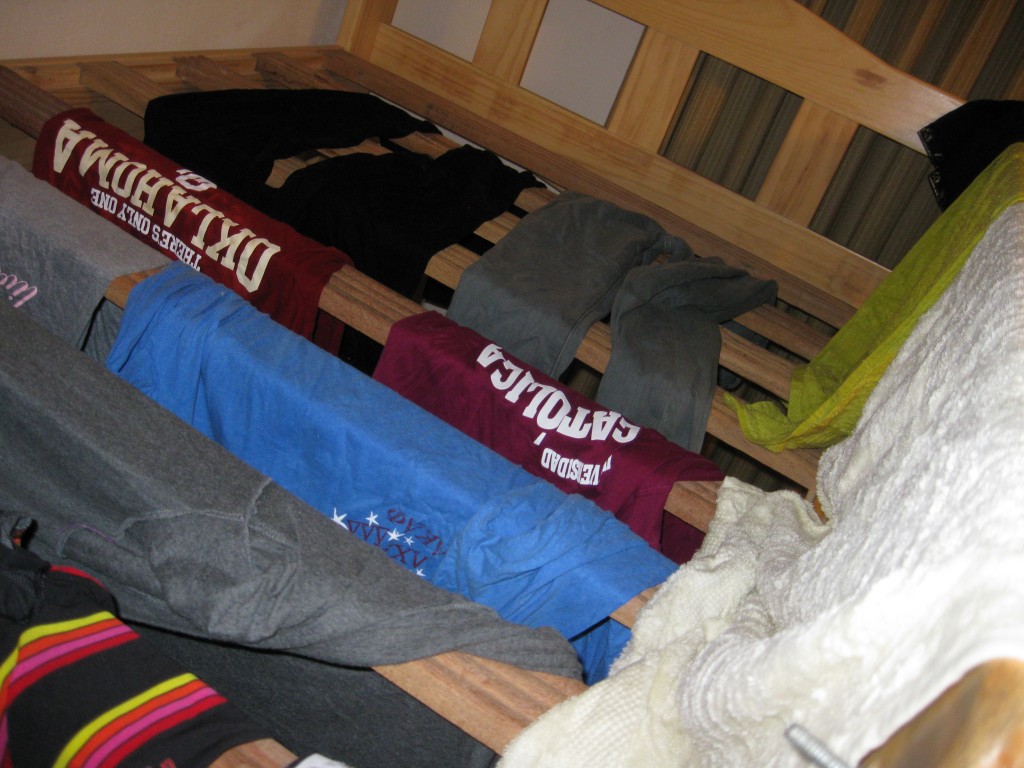
I hung my clothes over Proomie´s unused top bunk (she sleeps on the bottom) for clothes to dry since the roof is full of clothes, but they did not dry in time. Proomie has a nice fort though!
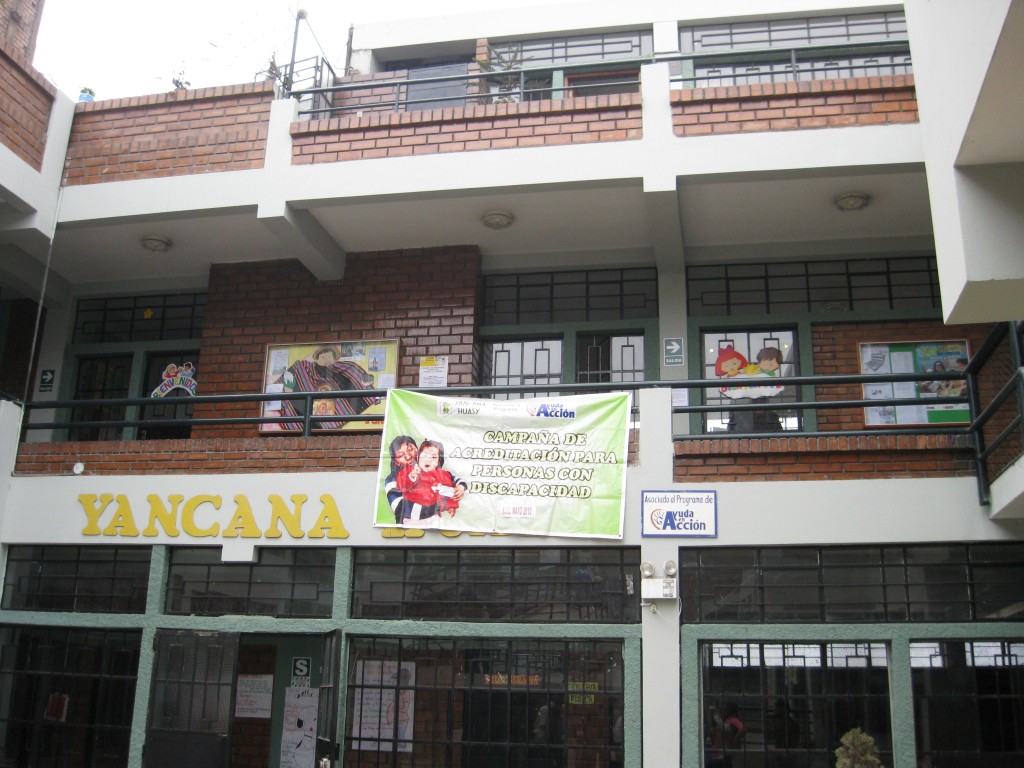
We went to Yancana Huasy, a school built by a priest in the 1980s for disabled children with services at a low cost.
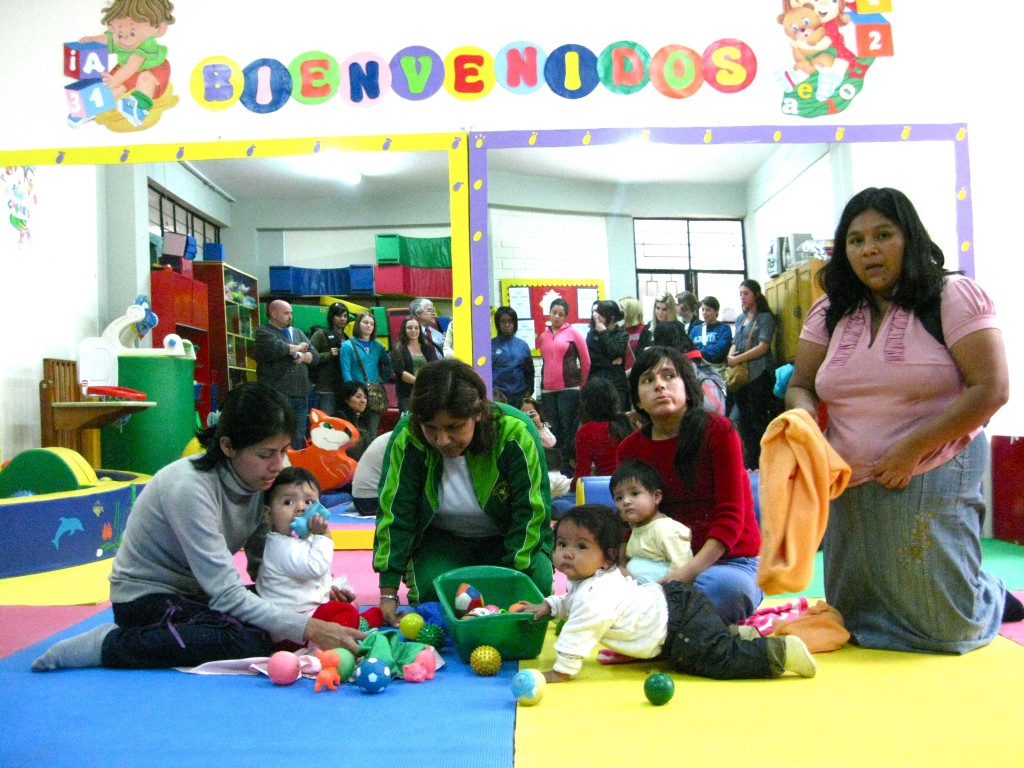
This was my favorite room in the school because I love babies!
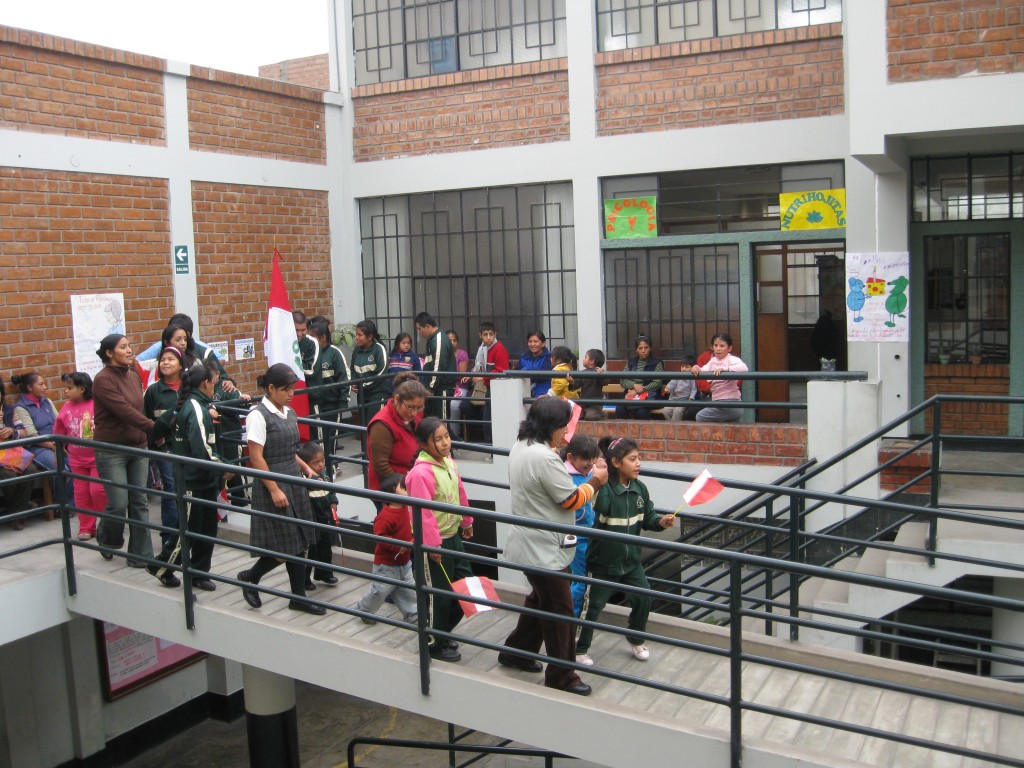
The students of Yancana Huasy are celebrating Flag Day here by parading down the stairs! This day honors those who were lost in battle and celebrates the Peruvians' allegiance to the flag.
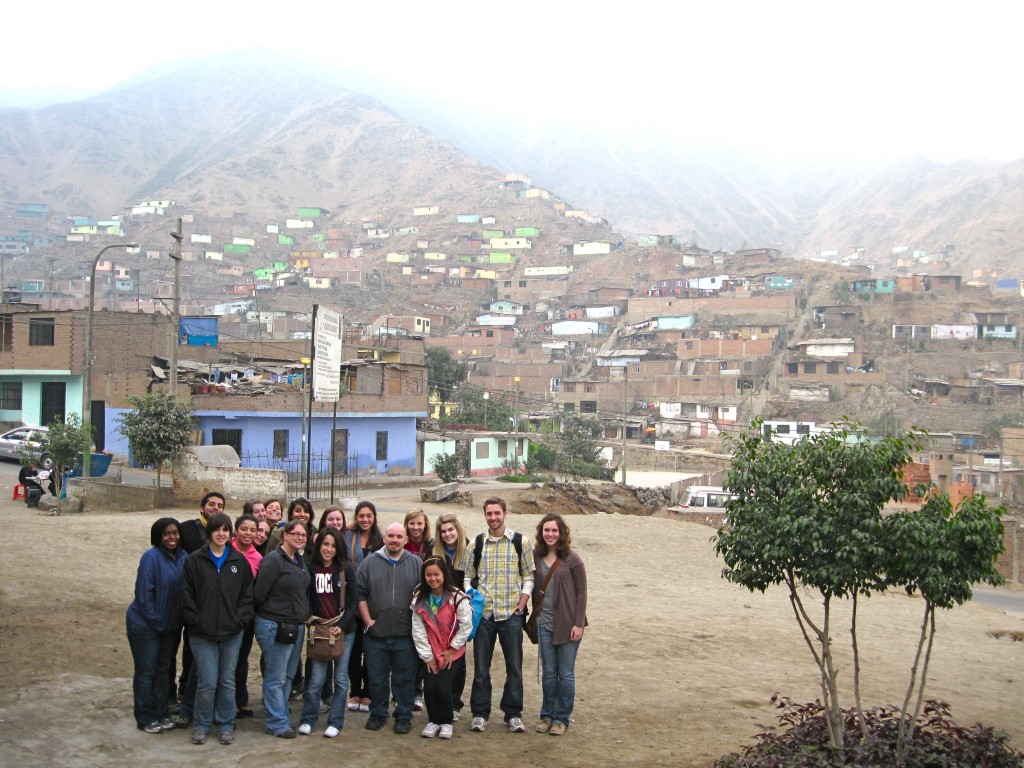
Canto Grande, a very poor part of San Juan de Lurigancho district (most populated district of Peru). Canto Grande is a shantytown that was previously uninhabited land, but was taken over by the very poor population of Peru.
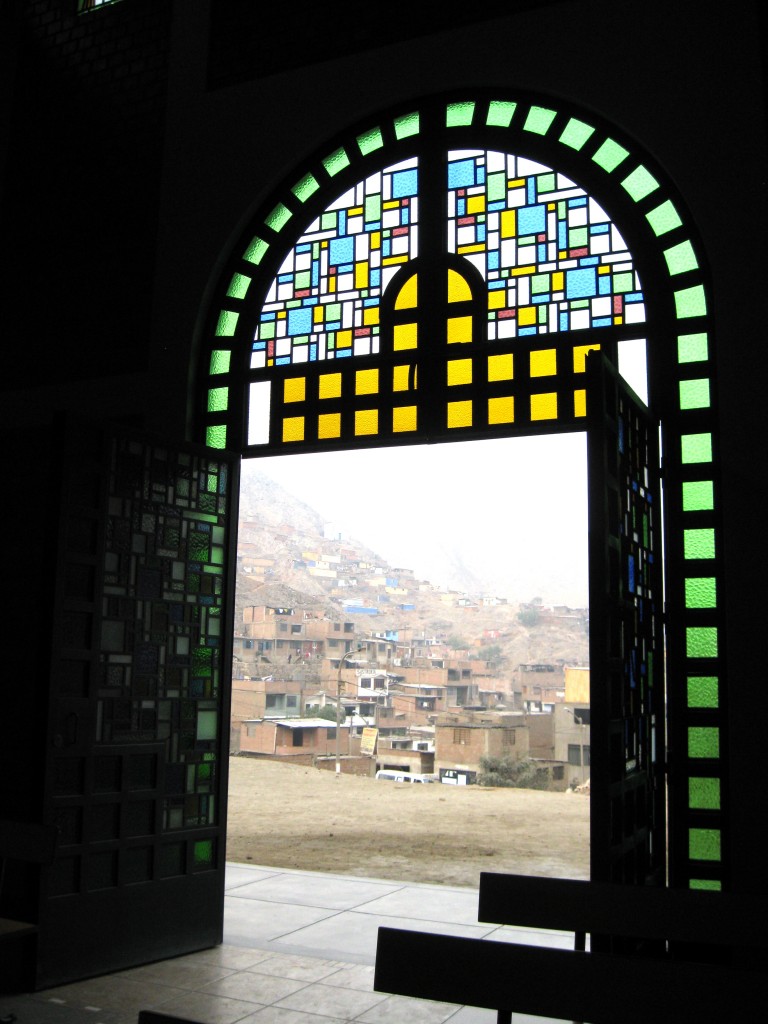
We later visited Lord of Hope Catholic Church, led by Fr. Jorge, in Canto Grande. This church also had a three-story office next to it with health services such as a dentist office, a health clinic, a pharmacy and even a health clinic specifically for women. The third floor is for pastoral offices. This was made possible by donations from Germany.

It was a humbling experience to see their contentment and hope even when they live in boxes with no/little electricity or water.
We had toast, bologna, cheese, condensed milk and peach juice for breakfast. I was kind of sad leaving our host family even though it’s only for a day because they’re so great to us. I feel like we are a family already after nine days!
It’s another foggy, cloudy day in Lima, but it’s Flag Day here! This day honors those who were lost in battle and celebrates the Peruvians’ allegiance to the flag.
Hillary Clinton is here for the 40th anniversary of the General Assembly of the American States. I really wish we could see her!
I tried to stay away from the “typical sorority look” and pack lightly during my stay in Peru, but I ran out of clean jeans and blouses; therefore, I am forced to wear the only clean clothes I have: leggings, tie-dye Tri Delta t-shirt, North Face jacket and North Face backpack. I’m ultimate sorority tourist on this campus today. 😀
I even hung my clothes over Proomie’s unused top bunk (she sleeps on the bottom) for clothes to dry since the roof is full of clothes, but they did not dry in time. Proomie has a nice fort though!
We talked about the poor population of Peru and Dr. Kenney’s experiences while living here for eight years. It’s astonishing how these poor Peruvians live with so little. I applaud Dr. Kenney for his experiences and dedication to the people of Peru. His family lived in Canto Grande, and they had to deal with contamination and sanitary problems. His children could not crawl because of the dirt floors, and he and his wife handwashed all their diapers. He expressed to us his happiness when he saw his children run through grass when they moved to the United States. I love hearing his stories because they are his own experiences, and they are inspiring!
We ate avocado salad with corn, peas and carrots; Peruvian roast with white rice; rolls and rice pudding and drank mango juice for lunch at the school cafeteria. I really enjoy the school food.
I saw a dozen Asian students eating the rolls on a fork while in line to get food–SO ASIAN…even in Latin America! Haha
We went to Yancana Huasy, a school built by a priest in the 1980s for disabled children with services at a low cost. Yancana Huasy also provides job training and work opportunities for disabled adults. This was also the perfect place to buy souvenirs because the money goes to fund school and programs. I bought six greeting cards, two coin purse key chains, a stone egg, a billfold and four bracelets for 68 soles (Peru’s currency, which currently equals about 2.82 soles for $1). I’m excited to give these souvenirs to friends and family and tell them about how their gift makes a difference. I enjoyed seeing God’s work through Peruvians helping the poor.
We later visited Lord of Hope Catholic Church, led by Fr. Jorge, in Canto Grande, a very poor part of San Juan de Lurigancho district (most populated district of Peru). Canto Grande is a shantytown that was previously uninhabited land, but was taken over by the very poor population of Peru. This is a beautiful church although it is in Canto Grande. This church also had a three-story office next to it with health services such as a dentist office, a health clinic, a pharmacy and even a health clinic specifically for women. The third floor is for pastoral offices. This was made possible by donations from Germany. I am overjoyed to learn that other countries and the Church are doing their part to help the poor of Peru. It was a humbling experience to see their contentment and hope even when they live in boxes with no/little electricity or water.
We are staying overnight at the Peyton Center, a multipurpose center named after a priest with classrooms, sleeping porches, auditorium and recreational services. This place is able to provide low-cost services to the poor through programs like ours who pay regular prices to help fund it. Although it is in Canto Grande, a poor and infamously dangerously area in Peru, we are safe with water, electricity and security. It’s fun to be with everyone overnight for a change. The ladies are on the second floor. I am staying with Kim, Kristina, Ashley, Whitley, Jenny, Faith, Lorri and Katherine in the second room. The rest of the gals (Carlee, Jane, Courtney, Caroline and Ann) are in the first room, and Ryan, Andy and Dr. Kenney are in a room on the first floor. We played basketball and soccer and visited until dinner (which seemed like forever because I was starving…as usual).
We had vegetables (corn, carrots, green beans and broccoli), mashed potatoes, roasted chicken with onions, bananas, clementines, apple pie and Inca Kola for dinner. The Peyton Center has excellent cooks! Dr. Kenney knew the cook from years ago when he lived here. We even helped with the dishes after dinner!
We were very fortunate to have this wonderful facility because the shanty houses and the very poor population around us had much less than we did.
It’s been another eye-opening day with another reminder of our many blessings.
Jun
7

Our wonderful host dad took us on a tour of Miraflores and Barranco, Lima's most popular districts, and the beach. The waves are very high.
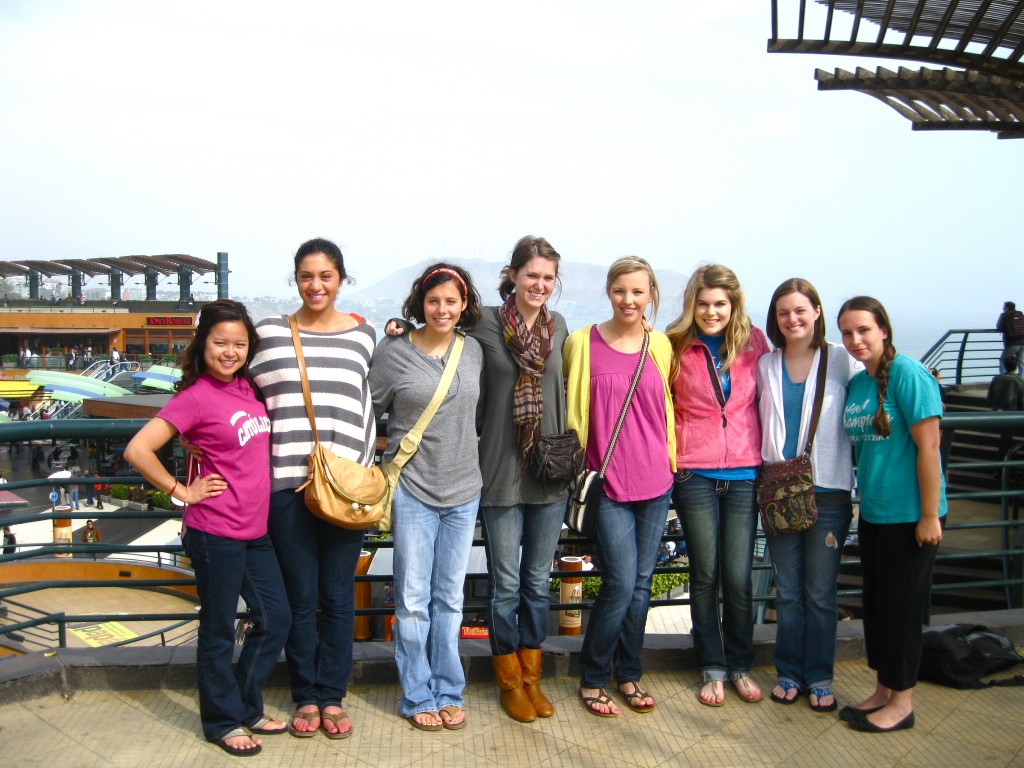
Eight of the OU Journey to Latin American girls who met up at Larcomar on our free day. We were across the street from the conference of political leaders. We found this out from a security guard. The street was blocked off, and there were many officials. We were told that Hillary Clinton was among the peoplethere.Some of us had mixed seafood ceviche, a process in which the seafood is cooked only by lime juice. It was interesting--not my favorite dish, but I'm glad I tried it!
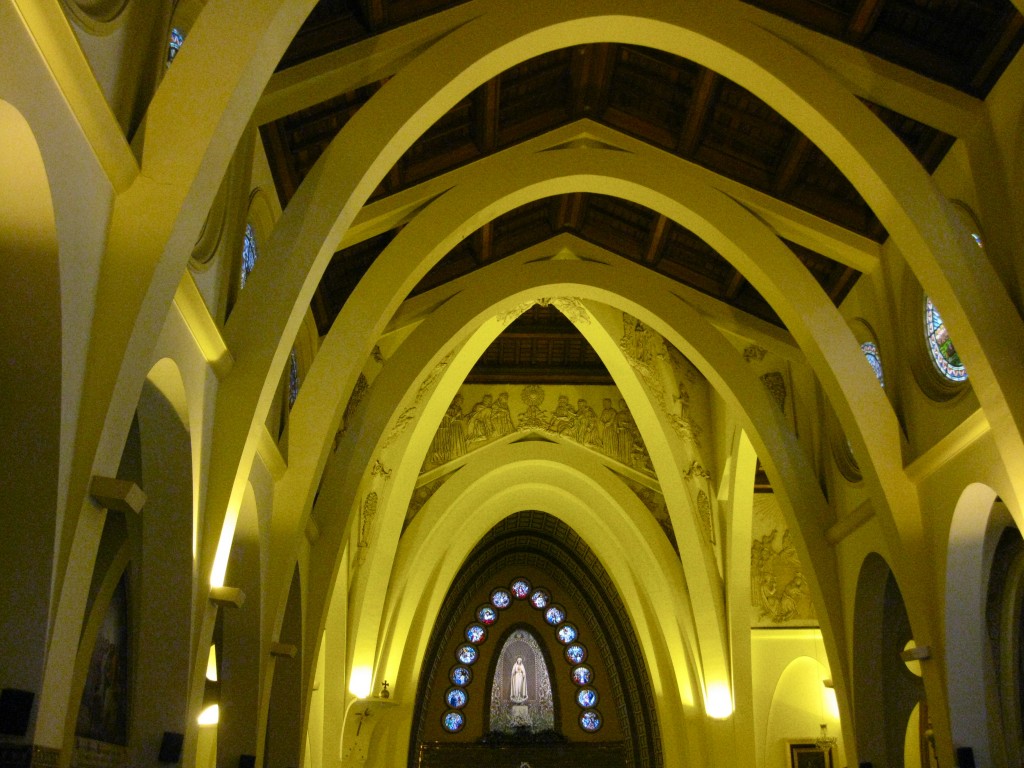
Jesus is SO good to us: We wanted to attend Mass today, but we were unable to attend morning Mass. He helped us to be in the right place at the right time because we got directions to a church a block from the shopping center we were at just in time for Mass.
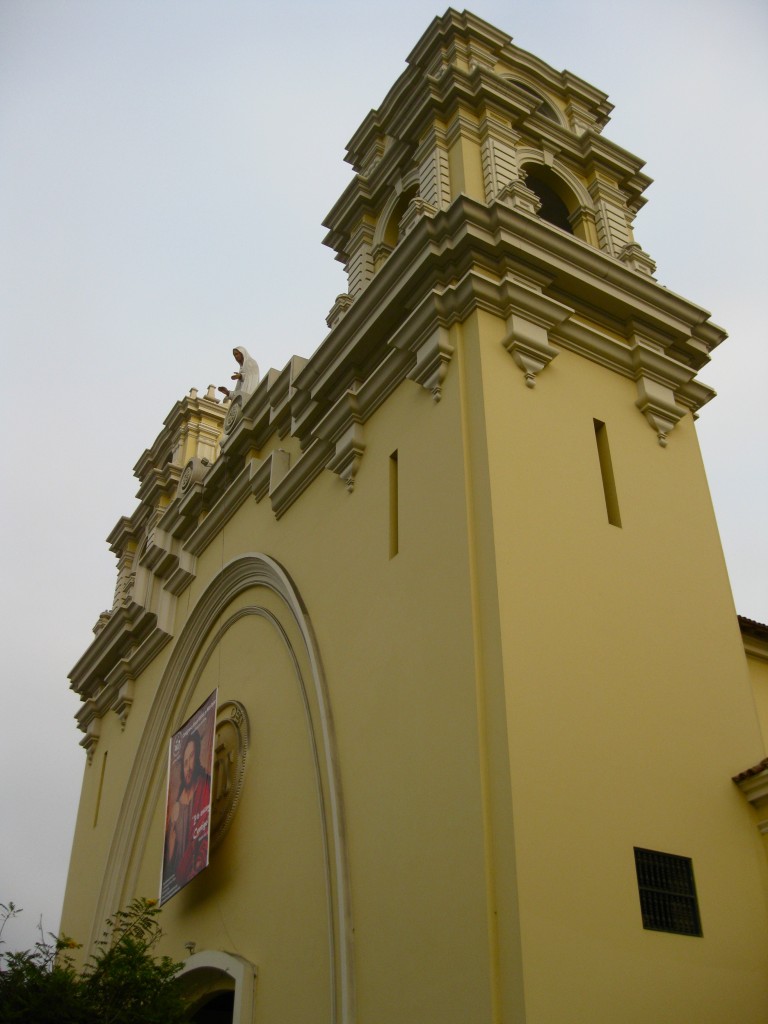
Ave Maria Catholic Church. It was cool to experience Mass in Peru!
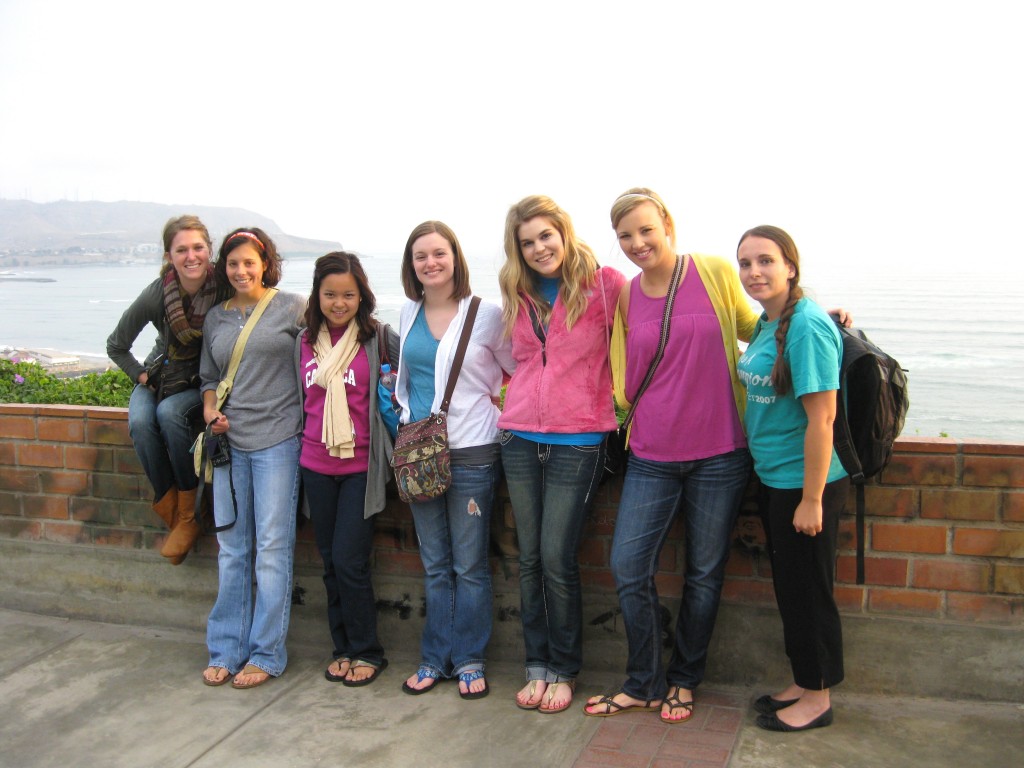
We had an awesome view of the beach by the church. We spent some time here before attending Mass.
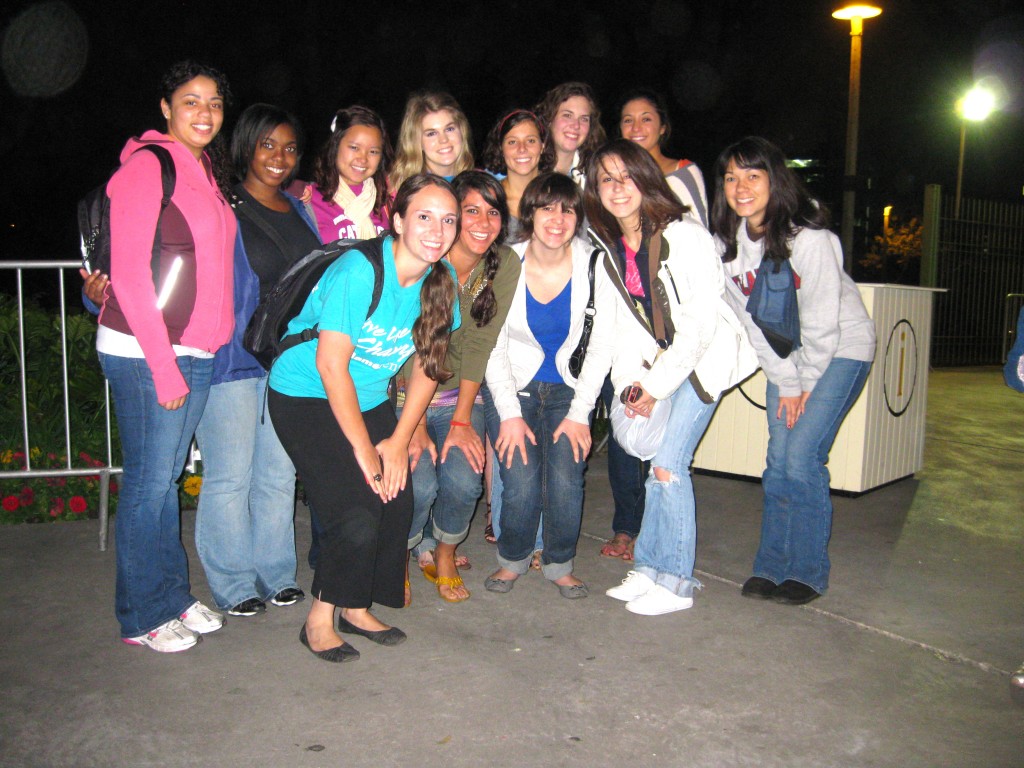
- After Mass, my housemates and I went to El Circuito Mágico del Agua (Magic Water Circuit). We ran into some of the other OU Journey to Latin America students. Two OU students who are studying in Lima for a semester also met with us.

El Circuito Mágico del Agua (Magic Water Circuit) is a water park consisting of many lighted fountains with different designs. One of them is multicolored and plays along to music. The water moves to the rhythm and images are projected on the water.
I didn’t go to bed until 3 a.m. because we got home around 2 from the Peña del Carajo, and I blogged, but we slept until about 10 this morning because today is was a free day! Our host family served yogurt, bread and jelly, Peruvian-style cereal and scrambled eggs mixed with sausage and a dash of Peruvian flavor for breakfast.
We are in the process of doing laundry here. Our host home has a washer, but we hang our clothes on the roof to dry. Because all five of us and the host family did laundry in the past two days, we are out of space on the rooftop to hang clothes to dry. Solution? I hung my clothes on top of the unused bunk bed. Proomie looks like she has a fort for a bed!
Our wonderful host dad took us on a tour of Miraflores and Barranco, Lima’s most popular districts, and the beach. The waves are very high. My Hello Kitty iPhone fell from a high rock and landed with no scratches or marks. I think it’s because HK has nine lives and protected my phone. 🙂
We had lunch at Vivaldino, a fancy Peruvian restaurant overlooking the beach. We decided it’s OK to spoil ourselves since this is the first (and probably only) meal we have to buy since the university and host families cover all our meals.
Some of us had mixed seafood ceviche, a process in which the seafood is cooked only by lime juice. It was interesting–not my favorite dish, but I’m glad I tried it! We were across the street from the conference of political leaders. We found this out from a security guard. The street was blocked off, and there were many officials. We were told that Hillary Clinton was among the people there.
After having lunch and walking around the shopping center, we had gelato, and I asked security about a church nearby and directions to get there.
Jesus is SO good to us: We wanted to attend Mass today, but we were unable to attend morning Mass. He helped us to be in the right place at the right time because we got directions to a church a block from the shopping center we were at just in time for Mass. It was cool to experience Mass in Peru at the Virgin of Fatima Catholic Church!
It’s awesome how Catholic services (Mass) are, for the most part, universal. Although I didn’t understand much of Mass because it was completely in Spanish, I knew exactly what went on. I was able to go along with everything in English.
I noticed people act differently in Mass here in Peru as compared to the United States. A few people walked in late, some as late as 20 minutes. A few people walked around during Mass; some parents walked around with their children and some people walked around for no apparent reason. I’m not sure why, but that’s new to me. There was a child who kept slamming the confessional door that was on the side of the church (and toward the front) during Mass, and his parents never stopped him. How is that OK? Lining up for communion was disastrous. There was no order. In the United States, we line up by rows, starting with the front; it’s first come, first serve in Peru. Since we did not know this, we were trapped in our seats in the middle until a nice lady (who recognized that we were visitors) let us in front of her. Wine was not an option. I’m not sure why. Also, Peruvians do not wait for the end of the concluding song or for the priest to walk to the back of the church before they leave. Most people left after communion or left as soon as concluding music began. The priest went straight from the altar to the side door in the back of the altar. Most priests in the United States come to the back of the church after Mass to shake hands with parishioners. Plus, Mass lasted only 45 minutes. I would never consider walking around during Mass or leaving before the priest leaves unless it’s an emergency.
Maybe it’s new to me or maybe I’m not used to it, but it seems that we show more respect in the Catholic Church in the United States. Maybe it has something to do with the fact that only about 15 percent of the 80 percent of Peruvian Roman Catholics attend Mass, according to Dr. Kenney. Even those who came to Mass seemed less interested in it than those I’ve observed in the United States. I find this to be true because the Peruvians I know said they believe in the Catholic faith, and they consider themselves Catholic, but they prefer not to attend Mass. Some say it’s because they have to work while others say they currently do not agree with the Church.
After Mass, my housemates and I went to El Circuito Mágico del Agua (Magic Water Circuit). It is a water park consisting of many lighted fountains with different designs. One of them is multicolored and plays along to music. The water moves to the rhythm and images are projected on the water. My favorite was the lighted water tunnel.
After the water show, we went to Wong, a supermarket and shopping center to buy a few necessities.
We traveled to many places today, and I had opportunities to practice Spanish with three taxi drivers, numerous security personnel and cashiers. I love this!
For dinner, our host family brought us Chifa (Peruvian-Chinese food) take-out. It was one of the best Chinese take-out I’ve ever had! We had a chicken noodle soup with bok choy; fried wontons; sautéed noodles with chicken and vegetables; pork rolls in sautéed vegetables; and sweet and sour chicken sautéed with wontons and vegetables. Basically we had our fill of sautéed goodness and vegetables. YUM!
Jun
6

San Francisco Monastery is huge! The outside is covered with hundreds of pidgeons.
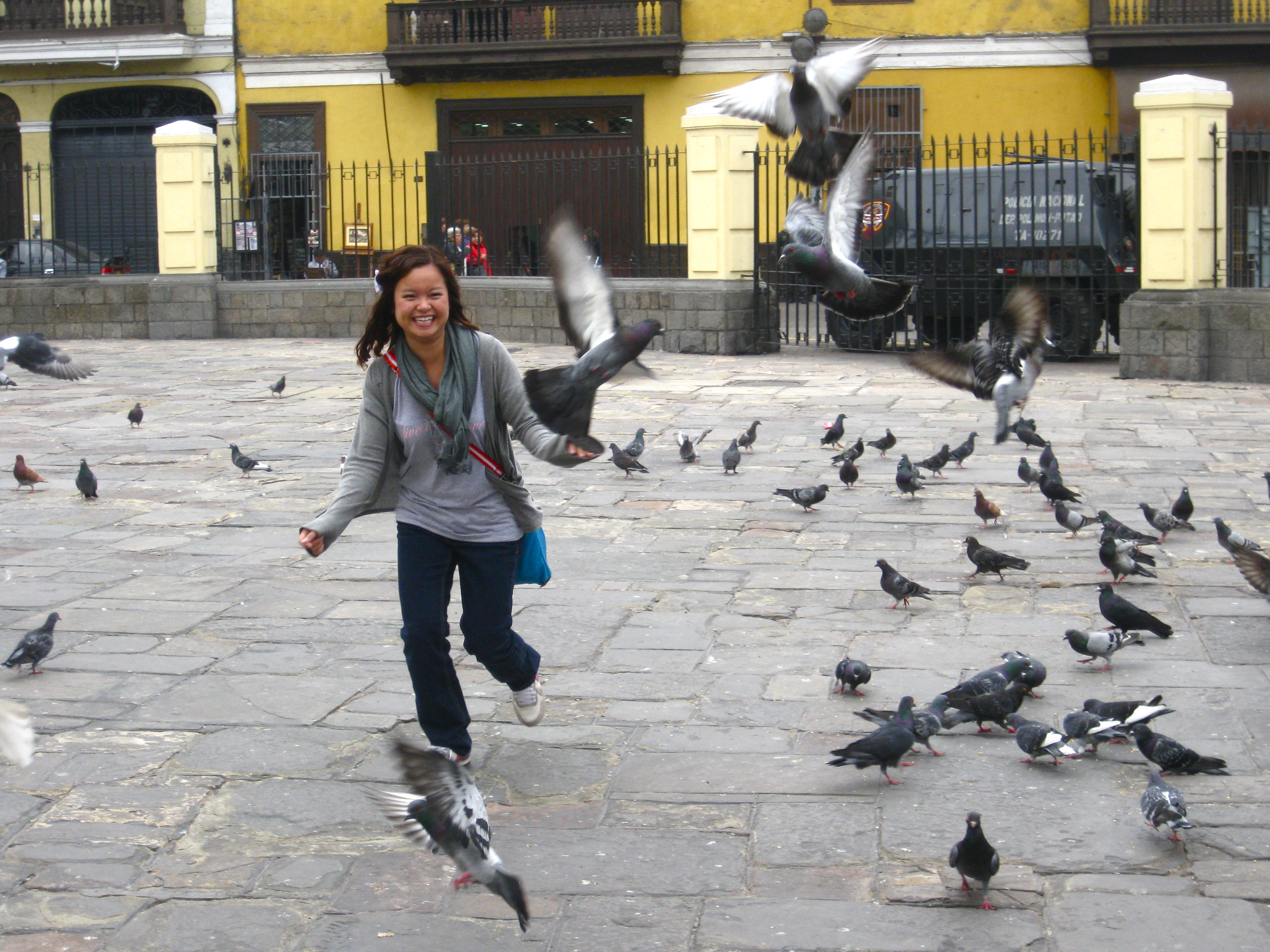
I’ve never seen so many birds in my life. Many parents took their children there just to people-watch and play with birds.
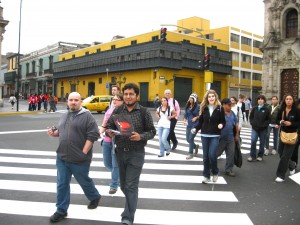
We toured the city on foot today. I felt like I was in a smaller version of Spain or Italy.
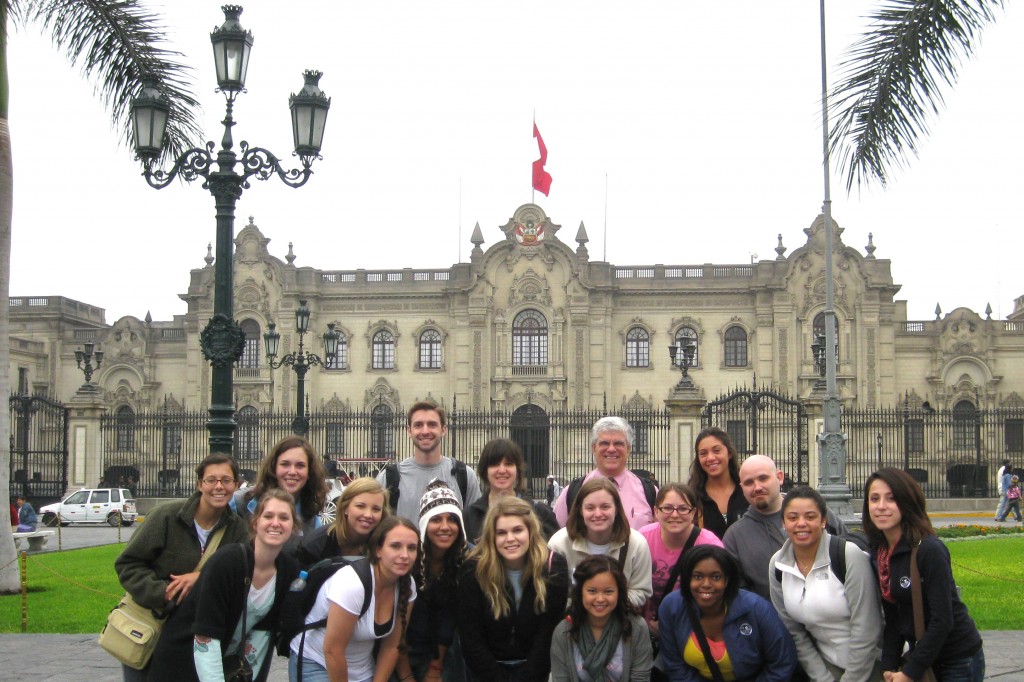
OU Journey to Latin American students enjoyed a day out touring the city and La Plaza Mayor
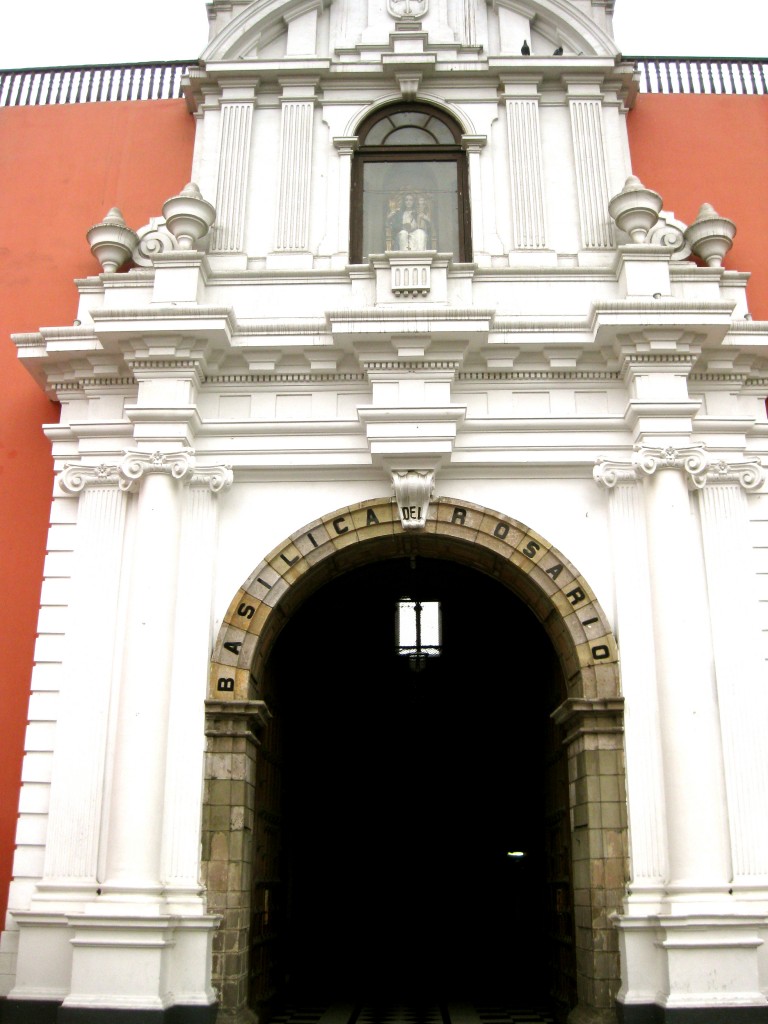
This is one of many entrances to Santo Domingo Church. I saw many Peruvians praying.
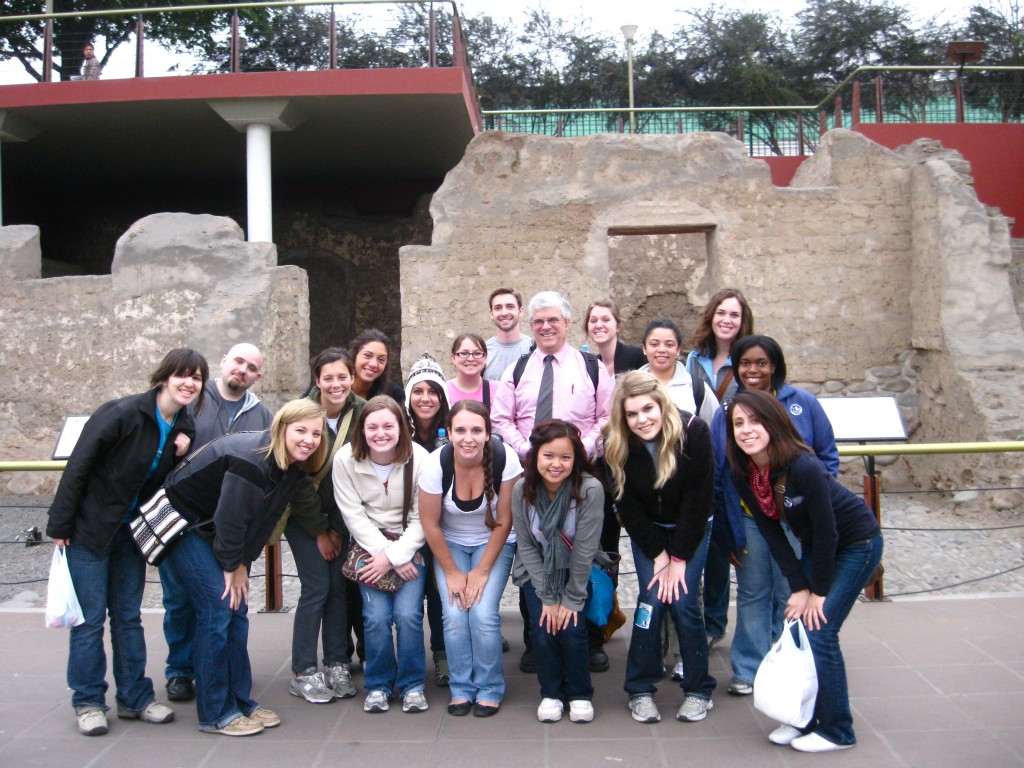
Parque de la Muralla was once barren and covered in dirt until it was discovered that underneath the dirt are homes from the 18th century. The government of Peru invested in restoring the area and turned it into a beautiful tourist attraction while keeping the homes as a historical site and incorporating modern fountains and staircases.
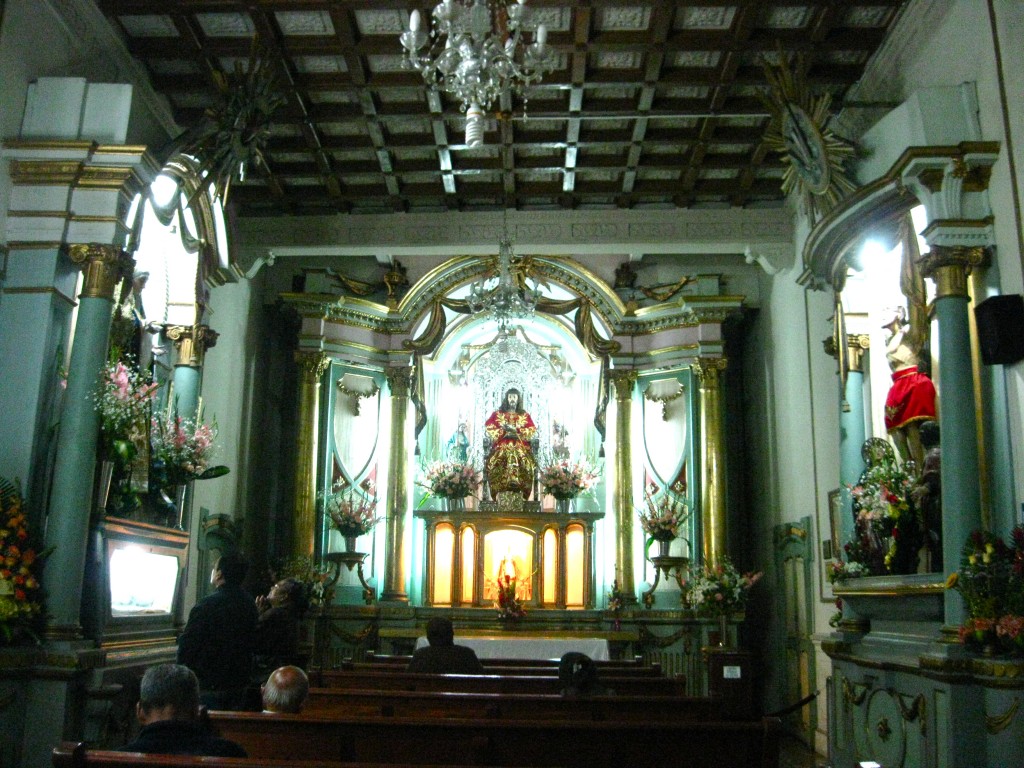
Santo Domingo church is beautiful! It’s also very elaborate. There were more natives than tourists in that church.
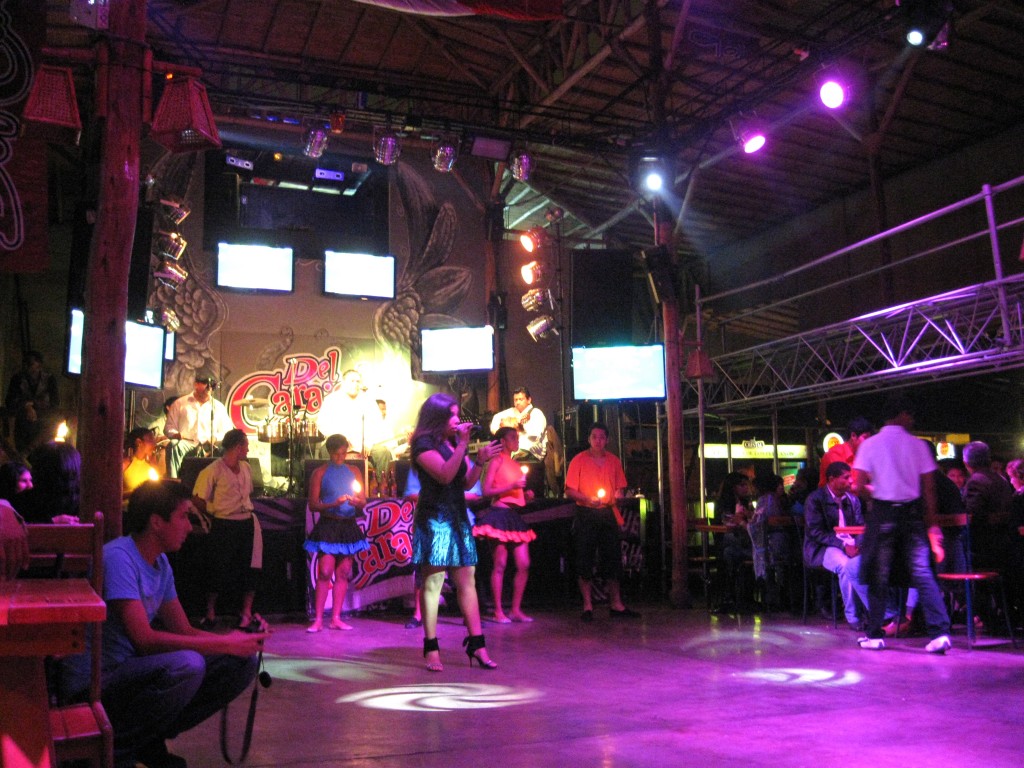
A peña is an Afro-Latin-inspired festivity with hundreds of people, dancing, food and drinks.
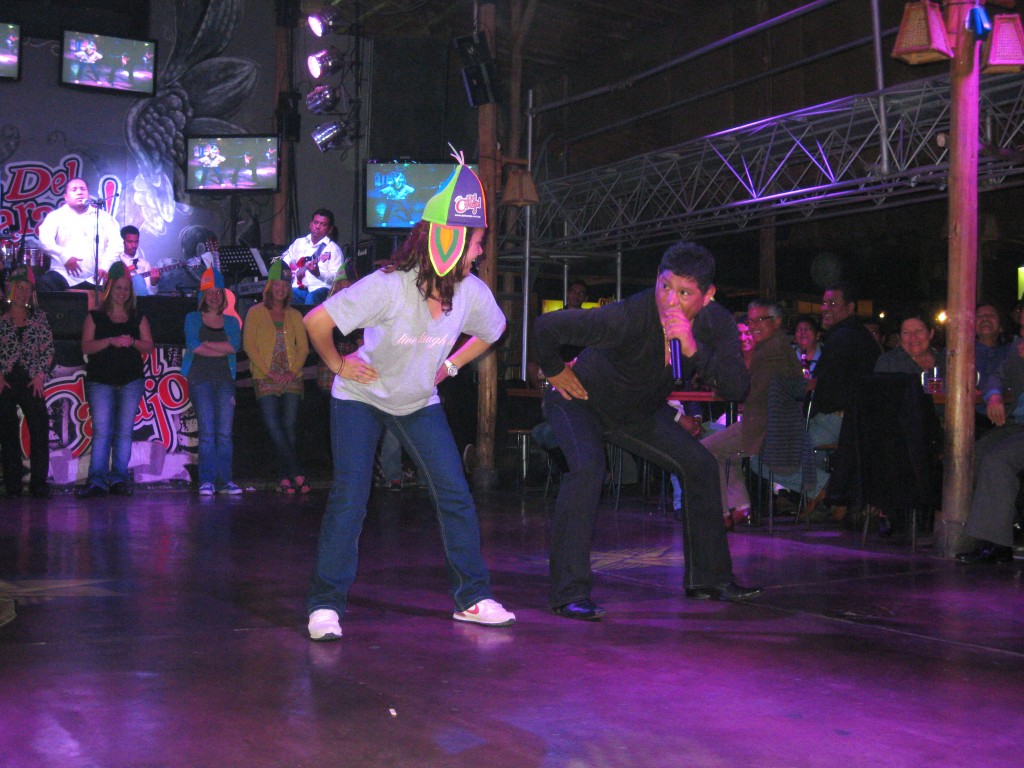
The emcee at the Peña del Carajo searched for foreigners to Perú, and I was asked to answer a questionaire in Spanish and show off dancing skills. I passed the speaking part, but apparently my "Pop, Lock and Drop It" and "YMCA" moves weren't sufficient because he insisted on teaching me to shake my hips and thrust in front of hundreds of people!
I went to bed before 2 a.m. for the first time in two weeks! I got more sleep last night than the past three nights combined. Yet I was still really sleepy. Maybe I need more sleep to catch up?
It was very humid and foggy this morning. The ground looked damp, but it didn’t rain. The weather reminded me of Forks, Washington, from the Twilight series, but Peruvian style. 🙂
We discussed the religious and slavery history of Peru in today’s class. Yes, OU Journey to Latin America students have class on Saturdays. There are classes for many students on Saturdays, so campus is still alive! It’s cloudy and chilly here, but the campus remains beautiful!
The school cafeteria stays open on Saturdays. We had avocado salad topped with red onions and a Peruvian-style ranch dressing, rotisserie-style chicken with rice, mixed vegetables (squash, carrots, broccoli and carrots) and flan for lunch. I love that rice and vegetables are with every meal here!
There was a graduation on campus, but we couldn’t figure out from which college or program. Their caps and gowns look just like ours in the United States.
We toured the city on foot today. My feet hurt! It was really exciting and different. It was exciting because I am Catholic, and Peru has so much Catholic history. It’s different from home because the architecture is not like that of Oklahoma. I felt like I was in a smaller version of Spain or Italy.
We visited San Francisco Monastery, La Plaza Mayor, Santo Domingo Gallery, Santo Domingo Church, San Martin Plaza and Parque de la Muralla.
San Francisco Monastery is huge! The outside of it is covered with hundreds of pigeons. I’ve never seen so many birds in my life. Many parents took their children there to people-watch and play with birds. Unfortunately, we were not allowed to take photographs or film, so it’s hard to give you a visual. The monastery was built in the 1500s. It still has bats living in it. Everything is so organized, elaborate and decorated. The strangest thing was the underground catacomb. Catacombs are ancient, human-made underground passageways for burial or protection. We saw bones of over 25,000 bodies. Some of them were displayed in a design.
La Plaza Mayor is very lively. There’s a fountain in the middle surrounded by yellow buildings.
Santo Domingo Gallery was a shopping center. We saw a lot of indigenous souvenirs, beadwork and rocks and porcelain upstairs. I didn’t buy anything because I want to buy the real-deal souvenirs from Cuzco. And I want to help the indigenous.
Santo Domingo church is beautiful! It’s also very elaborate. I saw many Peruvians there praying. There were more natives than tourists in that church.
Parque de la Muralla was once barren and covered in dirt until it was discovered that underneath the dirt are homes from the 18th century. The government of Peru, then, invested in restoring the area and turned it into a beautiful tourist attraction while keeping the homes as a historical site and incorporating modern fountains and staircases.
And we saw a senior citizen with his dog whom he taught to pose for tourists in glasses, a hat and a scarf–I wanted to play with him!
Later that night, Dr. Kenney and 16 of the 17 OU Journey to Latin America students went to the Peña del Carajo in Barranco, one of the oldest districts and about a 30-minute drive from our host home in Lima. A peña is an African Latin-inspired festivity with hundreds of people, dancing, food and drinks. Music ranged from Latina to techno to Elvis and “Grease.”
Being a journalist, the music at the peña made be think about Peru’s media regulations. I am writing my research paper over media consumption and changes the government has made from 1980 to 2000. How does the government regulate media such as copyright violations?
The highlight of my night was when the emcee at the Peña del Carajo searched for foreigners to Perú, and I was asked to answer a questionnaire in Spanish and show off my dancing skills.
He and the music crew teased me about being Asian, and chanted “China.” He also bowed to me, I bowed back and we both performed some improv of karate moves. Hundreds of people in the place found it amusing. I did not have my feelings hurt; I found it entertaining. I know they meant it in an endearing way.
I passed the speaking part, but apparently my “Pop, Lock and Drop It” and “YMCA” moves weren’t sufficient because he insisted on teaching me to shake my hips and thrust in front of hundreds of people!
Peru is so much like Vietnam. Vietnam and Peru have similar plants, infrastructure and markets. It breaks my heart when I see senior citizens on the streets begging or forced to work instead of enjoying their later years and playing with grandchildren. I find my heart breaking in Peru when I see Peruvian senior citizens pushing a bread cart or sitting on the corner selling key chains to tourists. I hope Peru’s economy, Vietnam’s economy and many others’ improve so that its citizens may have better lives.
Peru commemorates its first anniversary of Bagua clashes today. The Bagua clashes were between indigenous protesters and security forces on a remote jungle highway in northern Peru in which 33 people were killed due to misunderstanding, discrimination and inequality. Please pray for the people of Peru and the rest of our world.
Jun
4

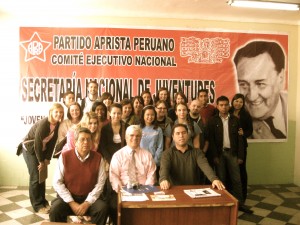
We met with APRA executive members, political candidates and political leaders.

This is the office of the founder of APRA, Victor Raúl.
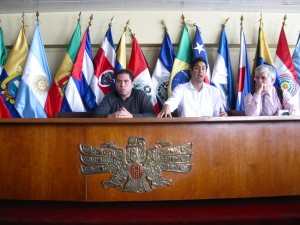
We toured the headquarters. Shown here are two APRA members and Dr. Kenney in the room where they have their executive meetings. The flags behind them are flags of Indoamerican (Latin American) countries.
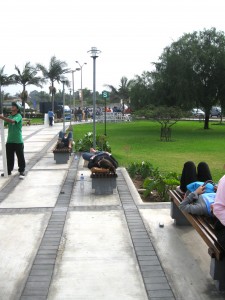
Kristina, Carlee and I napped on a bench outside on PUCP campus after lunch. It was wonderful!

We later visited the headquarters of political party Partido Popular Cristiano (Popular Christian Party).
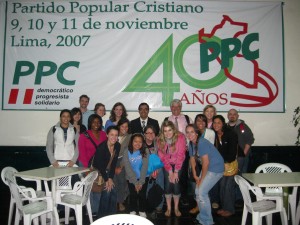
The national secretary of PPC educated us on its history. I was glad to learn PPC's leader is a woman and that its policies and ideals are based on moral and ethical values.
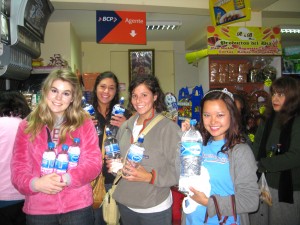
We went to a neighborhood store and bought plenty of water. Can you tell we're tourists?

We bid farewell to our sweet housemate, Joanna (middle), as she heads back to the Canary Islands.
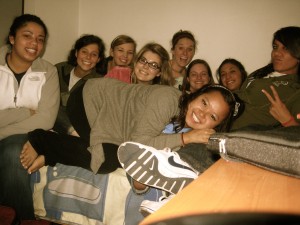
We're not going out tonight because we went out the past three nights. Instead, all OU Journey to Latin America students are coming over to our host home.
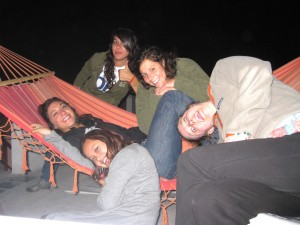
We created our own “fiesta” and hung out on the rooftop fully equipped with tables, chairs, a hammock and a beautiful view of Lima!
I stayed up until 4 a.m. blogging about yesterday because it was the most educational and emotional day thus far. I hadn’t cried in a while, and I shed plenty of tears yesterday.
I’m wasn’t sure how I stayed awake today on three hours of sleep, but it happened!
The weather is usually cloudy and humid in the 60s because it is winter here, but the sun has been out the past two days. I can’t believe we’ve been here six days!
Dr. Kenney taught us about Peru’s political history and political system in today’s class.
We moved lunch back to a later time because we were given a last-minute opportunity to visit the headquarters of political organization APRA (Alianza Popular Revolucionaria Americana). We met with executive members, political candidates and political leaders. I was excited to see the clinics, cafeteria, pharmacy and other services for the Peruvian poor. I spoke in Spanish to two of the women there about these services, and they were helpful and informative. I did not know some organizations like APRA provided these services.
We had rice with steak, potatoes, Peruvian-style pizza and fruit cocktail for lunch in the campus cafeteria. I also bought flan from the campus bakery, and Kristina, Carlee and I napped on a bench outside on PUCP campus after lunch. It was wonderful!
We later visited the headquarters of political party Partido Popular Cristiano (Popular Christian Party). The national secretary of PPC educated us on its history. I was glad to learn PPC’s leader is a woman and that its policies and ideals are based on moral and ethical values.
Kim, Carlee, Jane, Dr. Kenney (My Peroomies AKA Proomies) and I are fortunate to have such a welcoming and helpful host home. The husband and wife are around a lot and always willing to help. Ricardo walks us out to the front gate of the house every morning, kisses us on the cheek and wishes us a good day. The wife is a great cook and always checks on us during meals to make sure we like the food. Also living in this four-story home are their sons (8 and 4 years old), Joanna (a traveler) and a male college student.
I haven’t spoken to our male neighbor much, but Joanna is very friendly. We were sad to find out she was leaving to go back home to the Canary Islands today, but we were blessed to make it home just in time to tell her good-bye as she was getting in the car headed to the airport. She brought only a backpack with her for 20 days in Lima—we all need to learn how to pack from her!
We had chicken tamales with diced red onions and lime juice sprinkled on top and pesto pasta with beef and homemade apple juice for dinner. Did I mention our host family’s cooking is the best?
We didn’t go out tonight because we went out the past three nights. Instead, all OU Journey to Latin America students came over to our host home.
We created our own “fiesta” and hung out on the rooftop fully equipped with tables, chairs, a hammock and a beautiful view of Lima!
I blogged much earlier tonight because I am determined to go to bed before 3 a.m. and sleep more than four hours. I’ll let you know how my plan turns out tomorrow!
Jun
4
A review of Thursday, June 3, 2010

I thought OU squirrels on campus were friendly...until I studied abroad at Pontificia Universidad Catolica del Peru!There was a huge dancing contest hosted by a drive to encouragement more active lifestyles. A radio station was also there with judges, and Latina, techno, hip-hop and American music were played.
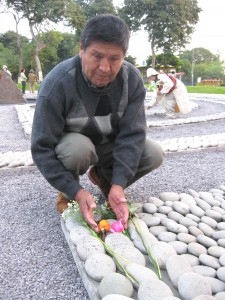
A Peruvian man embracing the symbol of his loved one whose life was ended due to terrorism and acts of violence.

We were blessed to see the memorial and remembrance ceremony for lives lost to terrorism and more blessed to participate and be inspired.
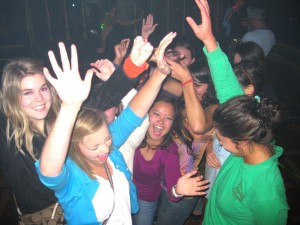
OU students showed Peruvians how to dance at VIP discoteca!

We somehow became friends with the owner of Latina discoteca!
Today has been the most educational and emotional day so far.
I stayed up until 2:30 a.m. blogging because I wanted to include many pictures, and the Internet here is slower. We had the usual condensed milk, ham and cheese, bread, jam, jelly, pâté, orange juice and pear juice for breakfast. We took a taxi to class because we ran late, and we had the sweetest driver!
We discussed Peru’s history of violence and social inequality and watched “State of Fear,” a documentary on political violence and human rights violations from 1980 to 2000.
For those who don’t know about Peru’s contemporary political history, let me attempt to give you a brief overview. A terrorist organization called the Shining Path that modeled its ideology from Mao’s Chinese Communist revolution began a campaign of violence against the people of Peru in 1980. Approximately 70,000 people died between 1980 and 2000 due to political violence. Peru’s Truth and Reconciliation Commission found that the Shining Path, “Sendero Luminoso” in Spanish, was responsible for about 54% of those deaths and the government was responsible for 38%. Other terrorist groups murdered the rest.
The Shining Path was brutal, and the government used arbitrary violence to fight against them. Most of those who died were poor, uneducated peasants in Peru’s highlands. The guerrillas forced the indigenous to join or support the Shining Path while government sources prosecuted everyone they believe to be a part of terrorist organizations. Many people had to pretend they were a terrorist one day, then a good citizen the next in order to dodge threats and violence by guerrillas or the state.
I held in tears during the video after watching the story of an innocent 19-year-old student who was abducted by the army while trying to enroll at college for the first time. She was beaten and questioned about student leaders of that campus. Because she had yet to enroll, she made up answers in order to stop her interrogators from beating her. The interrogators then injected her, ripped her clothes off and raped her three times. She was a virgin before the incident, but became pregnant and gave birth to a girl while in prison. She said she did not care if she were killed or imprisoned because her innocence and her life were robbed from her. She was only one of many cases.
It was sad to learn about the injustices, but it reminded me of God’s work through journalists, human rights activists and political leaders. I’m optimistic about Peru’s future due to the passionate and heroic figures and the Truth and Reconciliation Committee.
Our lunch at the university consisted of tasty Chifa, Peruvian-style Chinese food: pork fried rice with fresh pickled carrots and daikon radishes. We also had chicha (peruvian drink made from purple corn), rolls and Peruvian pudding. My usual extremely loud and obnoxious sneeze scared the table of Peruvians next to us, and they reenacted my sneeze as a tsunami.
Kim and I roamed the beautiful campus on this sunny day and found fun activities! There was a huge dancing contest hosted by a drive to encourage more active lifestyles. A radio station was also there with judges, and Latina, techno, hip-hop and American music were played. We later found a drama production, and more friendly deer approached me!
We met with a member of the Institute of Democracy and Human Rights of our university. The man who had worked on the Truth and Reconciliation Commission report was helpful in enlightening us about Peru’s 20 years of political violence.
We later went to the park of monuments in Jesus Maria district. The most important and controversial one is a memorial called El Ojo Que Llora (The Eye that Cries). This memorial is a fountain with water dripping from it surrounded by a labyrinth of stones, each representing one of the 70,000 who were killed in the violence.
While some support this memorial because they want to remember and honor those murdered, others say the monument is a shrine to the Shining Path and other terrorist groups. It’s controversial because some of the names in the memorial are names of members of terrorist groups. It’s difficult to take out the names of the terrorist members because it’s difficult to know whom truly supported terrorism since some only said they did to stay alive. Also, some Peruvians want to forget their violent history and move on toward the future, while others feel it’s necessary to remember everything, even the corruption.
Supporters of Peru’s former president, Alberto Fujimori, vandalized this monument in 2007. “Fujimoristas,” supporters of the Fujimori regime, splattered the monument with orange paint and smashed some of the stones with hammers.
We did not know there was going to be a ceremony, but we arrived just in time. The director of the ceremony asked us to participate in placing newly inscribed stones in their permanent resting places. I found it a sign that there were exactly enough stones for all OU students. Not to mention, who would have carried those stones and honored those souls if we were not there?
Each OU student carried a stone with the name of a victim, year of death and age. I carried the stone of Luis Garayar Martinez who died in 1984 at the age of 44. I don’t know if he was a victim or terrorist, but this made the 20 years of violence come to life for me. I didn’t care if he was innocent or not; all I could think about were the lives changed because of his death and the death of many others. As I began to pray for his soul and healing for many Peruvians, I had chills…chills of inspiration, chills that reminded me of my purpose as a human being and as a professional. I want to help others in my role as a person, and I want to let the world know of injustice, inequality and human rights violations through my reporting as a journalist.
As I placed the stone down for its permanent home in the memorial, I was proud of myself for holding in tears until a Peruvian senior citizen tapped me on the soldier and asked me to follow him. He showed me the stone of his loved one wrapped with two roses. He then spoke to me in Spanish and asked to take his picture. I suppose he had noticed me taking many pictures and felt that the memory of his relative is also picture-worthy. He held the small stone with the name Heraclides Pablo Meza (I believe), 24 years, La Cantuta, July 18, 1992, on it. The crazy thing is all that information was hand-inscribed on the stone. That means his relative or friend was not honored on that day, but he came to remember, and I imagine he will continue to return to the memorial to remember until it is Heraclio’s turn to get a real stone. My emotions all poured out at once as I realized the stone is all he has of his lost loved one.
I took multiple pictures, bid him farewell and walked away before I had the opportunity to scare him with my crying. As I stood in solitude waiting for instructions on our exit, I had an idea. Of the 250 photos I took today, the ones I took for him and his loved one were the most important to me.
I walked up to that man and asked for his address in Spanish. He was confused, and his relative and wife approached me. I explained to them that he had asked me to take photos of him and the memorial stone. His relative gave me his e-mail address. I hope to e-mail him these photographs so that he may have something more than just a temporary stone.
We were blessed to see the memorial and remembrance ceremony for lives lost to terrorism and more blessed to participate and be inspired. I learned and felt so much in that hour of being around the memorial.
What do you think? Should the innocent be forgotten because of some corrupted citizens? Should the past be remembered if it is one of violence, pain and corruption?
Our host family served us a Peruvian-style egg drop soup made of glass noodles, flower-shaped pasta, slices of ginger, carrots and green onions for the appetizer–the best egg drop soup I’ve ever had, and I’ve had plenty! Then we ate aji de gallina: pulled hen (older chicken) in a gravy-like sauce, mashed potatoes and rice. I had Inca Kola (a soda that looks like Mountain Dew but tastes like bubble gum) for the second time, and it’s growing on me!
We went to La Calle de Pizzas en Miraflores to celebrate Whitley’s 21st birthday! Although the drinking age is 18 in Peru, she still went out with a bang! We went to two discotecas (clubs): VIP and Latina. We somehow became friends with the owner of Latina, and I brought my cranberry juice in a water bottle everywhere. Yes, I got crunk on some cranberry juice and tore up that Peruvian dance floor! I really enjoy taxi rides because I get to practice Spanish with the friendly drivers!
Jun
3
A review of Wednesday, June 2, 2010
- Our typical day in class. We learned about politics in the republic and had a quick overview of Peru’s political history until 2000 today.
- You know OU has friendly squirrels? Well, Pontificia Universidad Catolica del Peru has friendly deer!
- We met a group of Peruvian elementary students, and we taught them to do “OU” with their arms. Boomer Sooner from Peru!
- OU students in front of Peruvian Congress
- Changing of the guards in front of the Memorial of the Unknown Soldier
- OU students enjoyed a visit to the Museum of Inquisition and Congress in Peru
- The fountains above Larcomar in Miraflores
- Larcomar, a shopping and dining center overlooking the sea. So much fun!
- The Journey to Latin America crew enjoying the breeze by the sea in Miraflores!
- We found a playground in Miraflores!
I went to bed at 1:30 a.m.; woke up at 7. I am so sore from walking everywhere, but I’m getting toned! Our host family served us Peruvian-style sausage, paté and fresh bread from the bakery. The weather is cool (high 50s) in the mornings, but so nice compared to hot Oklahoma summers!
I have shin splints from climbing ancient civilization sites and dodging crazy Peruvian traffic. Traffic regulations don’t really exist here: a stop sign is basically a suggestive yield sign, and drivers do NOT yield to pedestrians…or anything.
We learned about politics in the republic and had a quick overview of Peru’s political history until 2000.
We found tables outside today and ate chicken and rice, yucca (tastes like potatoes, but it’s a root), Peruvian salad and flan for lunch.
We played with the friendly deer–I counted eight on campus! The weather is beautiful here in the 60s. It’s funny to see Peruvians wear boots and scarves in what we’d consider spring weather in Oklahoma.
We went to the Museum of Inquisition and Congress, the Congress building and the Memorial of the Unknown Soldier. We taught a group of elementary students to make “OU” with their arms. Boomer Sooner from Peru!
Our host family, as usual, cooked us an amazing meal for dinner: Peruvian-style spaghetti with beef strips, tomatoes, onions and carrots in a seasoned oil-based sauce and rice pudding sprinkled with cinnamon on top.
After dinner, we chatted with Dr. Kenney and our “host father,” Ricardo, about Chinese food and pizza in Peru. Then Kim and I headed to Larcomar, a mall overlooking the sea. Larcomar is located in Miraflores, a commercial district visited by many. It is beautiful!
Kim and I walked around, took pictures and ate. I had a pork empanada, Kim had a sprinkled cookie, and we both ate strawberry gelato.
We weren’t able to do much shopping because the stores close at 10 p.m., and I was sad because I saw the Sanrio store just at that moment. Hopefully I will find another Hello Kitty store before the end of this trip!
I withdrew money for the first time in Peru using an ATM, and I felt safe because there was a security guard in the area.
We met the rest of the study abroad crew and the two other OU students studying in Peru (who spoke to our class Monday) at a restaurant and had a great time talking about the adventures we had so far.
Jun
2
A review of Tuesday, June 1, 2010
Kim and I went to bed at 11 p.m. after blogging and editing photos, in spite of the early hour we were still super sleepy!
Our schedule: We wake up at 7 a.m., eat breakfast at 8 and walk to class at 8:30 to be at Pontificia Universidad Catolica del Peru by 9 for class. Lunch is at noon, and we ate in the cafeteria with other students for the first time today!
We learned about Peru’s diverse geography and how it affects the development of politics, economy, people and many others. We also learned about the ancient cultures.
We ate lunch earlier than most students, but the cafeteria was still very crowded, and all the tables were taken. Being innovative, I suggested we sit outside using benches as tables, so that’s what we did. We had a Peruvian lunch (pear juice, rolls, avocado salad, fish, rice and beans) Asian style sitting on the ground outside!
After lunch, we went to the ancient ruins of Pachacamac and drove by the beach, Charrillos and a shantytown. The view on top of El Templo del Sol is beautiful!
The “South Oval” of our university (PUCP) here is just as nice except there are deer instead of squirrels–so cool!
We went to the outdoor mall next to the famous Wong store–it’s big with a few American stores. I didn’t care for the style of clothing, but I really wanted to buy a tiny puppy from the pet shop.
We had a Peruvian-style egg drop soup with homemade croutons and cheese, corn on the cob (SO sweet and the best I’ve ever had), mashed potatoes and fish with avocados for dinner. Our host and hostess are the best cooks!
All but one of the girls (that’s 14 gals) went out on the town for the first time tonight! Our sweet Peruvian guide, Luis, arranged for taxis to pick us up at our host homes, and all the taxis drove together to “Atlantic City”–apparently Peru’s biggest casino–on top of a cliff overlooking the beach. Although I didn’t win anything, I had a blast!
- Our innovative way to eat lunch…using benches as tables and enjoying nice weather at the same time!
- OU Students on top of the ancient ruins of Pachacamac.
- The ancient ruins of Pachacamac
- Atlantic City, one of Peru’s most famous casinos
- Atlantic City, a fun casino built on top of a hill by the beach


